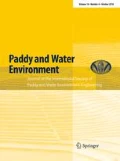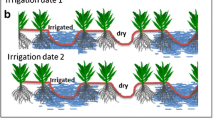Abstract
Water productivity (WP) expresses the value or benefit derived from the use of water. A profound water productivity analysis was carried out at experimental field at Field laboratory, Centre for Water Resources, Anna University, India, for rice crop under different water regimes such as flooded (FL), alternative wet and dry (AWD) and saturated soil culture (SSC). The hydrological model soil-water-atmospheric-plant (SWAP), including detailed crop growth, i.e, WOFOST (World Food Studies) model was used to determine the required hydrological variables such as transpiration, evapotranspiration and percolation, and bio-physical variables such as dry matter and grain yield. The observed values of crop growth from the experiment were used for the calibration of crop growth model WOFOST. The water productivity values are determined using SWAP and SWAP–WOFOST. The four water productivity indicators using grain yield were determined, such as water productivity of transpiration (WPT), evapotranspiration (WPET), percolation plus evapotranspiration (WPET+Q) and irrigation plus effective rainfall (WPI+ER). The highest value of water productivity was observed from the flooded treatment and lowest value from the saturated soil culture in WPT and WPET. This study, reveals that deep groundwater level and high temperature reduces the crop yield and water productivity significantly in the AWD and SSC treatment. This study reveals that in paddy fields 66% inflow water is recharging the groundwater. There is good agreement between SWAP and SWAP–WOFOST water productivity indicators.










Similar content being viewed by others
References
Allen RG, Pereira LS, Raes D, Smith M (1998) Crop evapotranspiration, guidelines for computing crop water requirements. Irrigation and drainage paper 56, FAO, Rome, Italy, pp 300
Belder P (2005) Water saving in lowland rice production: an experimental and modeling study. Dissertation, Wagenigen University, Wagenigen, The Netherlands.
Belmans C, Wesseling JG, Feddes RA (1983) Simulation of the water balance of cropped soil: SWATRE. J Hydrol 63:271–286
Boesten JJTI, Stroosnijder L (1986) Simple model for daily evaporation from fallow tilled soil under spring conditions in temperate climate. Netherland J Agric Sci 34:75–90
Bouman BAM, Tuong TP (2001) Field water management to save water and increase its productivity in irrigated lowland rice. Agric Water Manage 49:11–30
Cardon GE, Letey J (1992) Plant water uptake terms evaluated for soil water and solute movement models. Soil Sci Soc Am J 32:1876–1880
Directorate of agriculture (2001) Crop production guide. Chepauk, Chennai, Tamil Nadu, India
Dong B, Loeve R, Li Y, Chen CD, Deng L, Molden D (2001) Water productivity in the Zhanghe irrigation system: issues of scale. In: Barker R, Loeve R, Li Y, Tuong TP (eds) Proceedings of an international workshop in water-saving irrigation for rice. Wuhan, China, March 23–25, pp 97–115
Feddes RA, Kowalik PJ, Zaradny H (1978) Simulation of field water use and crop yield. Simulation monographs, Pudoc, Wageningen, The Netherlands, pp 189
Goudriaan J (1977) Crop meteorology: a simulation study. Simulation monographs, Pudoc, Wageningen, the Netherlands
Ines AVM, Droogers P, Makin I, Das Gupta A (2001) Crop growth and soil water balance modeling to explore water management options. IWMI Working Paper 22. International Water Management Institute, Colombo, Sri Lanka
Jackson ML (1973) Soil chemical analysis. Prentice-Hall, New Delhi
Kijne J, Barker R, Molden D (2003) Water productivity in agriculture: limits and opportunities for improvement. Comprehensive assessment of water management in agriculture, vol Series No. 1. CABI press, Wallingford, pp 352
Kite GW, Droogers P (2000) Comparing evapotranspiration estimates from satellites, hydrological models and field data. J Hydrol 229:3–18
Kroes JG, Van Dam JC, Huygen J, Vervoort RW (1999) User’s Guide of SWAP version 2.0 Simulation of water flow, solute transport and plant growth in the Soil-Water-Atmosphere-Plant environment. Technical Document 48, Alterra Green World Research, Wageningen, Report 81, Department of Water Resources, Wageningen University, pp 127
Leffelaar PA, Van Dam JC, Bessembinder JJE, Ponsioen T (2003) Integration of remote sensing and simulation of crop growth, soil water and solute transport at regional scale. In: Van Dam JC, Malik RS (ed) Water productivity of irrigated crops in Sirsa district, India. Integration of remote sensing, crop and soil models and geographical information systems. WATPRO final report, including CD-ROM. ISBN 90–6464–864–6, pp 121–134
Lovenstein HM, Lantinga R, Rabbinge R, Van Keulen H (1995) Principles of production ecology: text of course F 300–001, pp 8. Fig. 8. Department of theoretical production ecology, Wageningen university and research centre, Wageningen, The Netherlands, pp 121 Open University, Heerlen. ISBN 90–358–1111–1, pp 247
Molden D (1997) Accounting for water use and productivity. SWIM Paper 1, International Irrigation Management Institute, Colombo, Sri Lanka
Molden D, Sakthivadivel R (1999) Water accounting to assesses and productivity of water. J Water Resour Dev 15:55–72
Molden D, Murray-Rust H, Sakthivadivel R, Makin I (2001) A water productivity framework for understanding and action. Workshop on water productivity. Wadduwa, Sri Lanka, November 12 and 13, 2001
Molden D, Murray-Rust H, Sakthivadivel R, Makin I (2003) A water productivity framework for understanding and action. In: Kijne J, Barker R, Molden D (eds.) Water productivity in agriculture: limits and opportunities for improvement. CABI publishing and International Water Management Institute
Monteith JL (1965) Evaporation and the environment. In: Fogg GE (ed) The state and movement of water in living organisms, Cambridge university press, pp 205–234
Monteith JL (1981) Evaporation and surface temperature. Quart J Royal Soc 107:1–27
Mualem Y (1976) A new model for predicting the hydraulic conductivity of unsaturated porous media. Water Resour Res 12:513–522
Singh R, Van dam JC, Jhorar RK (2003) Water and salt balances at farmer fields. In: Van Dam JC, Malik RS (eds.) Water productivity of irrigated crops in Sirsa district, India. Integration of remote sensing, crop and soil models and geographical information systems. WATPRO final report, including CD-ROM. ISBN 90–6464–864–6, pp 41–58
Smith M (1992) CROPWAT, a computer programe for irrigation planning and management. Irrigation and drainage paper 46, FAO, Rome, Italy
Spitters CJT, Van Keulen H, Van kraalingen DWG (1989) A simple and universal crop growth simulator: SUCROS87. In: Rabbinge R, Ward SA, Van laar HH (eds) Simulation and systems management in crop protection. Simulation monographs, Pudoc, Wageningen, the Netherlands, pp 147–181
Supit I, Hooyer AA, Van deepen CA (1994) System description of the WOFOST 6.0 crop simulation model implemented in CGMS. Vol 1: theory and algorithms. EUR publication 15956, Agriculture series, Luxembourg, pp 146
Tietje O, Tapkenhinrichs M (1993) Evaluation of pseudo-transfer functions. Soil Sci Soc Am J 57:1088–1095
Tuong TP, Bouman BAM (2003) Rice production in water-scarce environments. In Kijne J, Barker R, Molden D (2003) Water productivity in agriculture: Limits and opportunities for improvement. Comprehensive assessment of water management of agriculture, series number 1, International Water Management Institute and CABI publication, UK, pp 352
Van Dam JC (2000) Field-scale water flow and solute transport. SWAP model concepts, parameter estimation, and case studies. Dissertation, Wageningen University, Wageningen, The Netherlands
Van Dam JC, Malik RS (2003) Water productivity of irrigated crops in Sirsa district, India. Integration of remote sensing, crop and soil models and geographical information systems. WATPRO final report, including CD-ROM. ISBN 90–6464–864–6
Van Dam JC, Huygen J, Wesseling JG, Feddes RA, Kabat P, Van Walsum PEV, Groenendijk P, Van Diepen CA (1997) Technical Document 45. Theory of SWAP version 2.0. Wageningen Agriculture University and DLO Winand Staring Centre, The Netherlands
Van Genuchten MTh (1980) A closed form equation for predicting the hydraulic conductivity of unsaturated soils. Soil Sci Soc Am J 44:892–898
Zwart J, Bastiaanssen WGM (2004) Review of measured crop water productivity values for irrigated wheat, rice, cotton and maize. Agric Water Manag 69:115–133
Acknowledgments
This study was conducted as part of Ph.D research work. The first author expresses his thanks to University Grants Commission, New Delhi, India for awarding Junior Research Fellowship. He also, expresses his thanks to Dr. R. Sakthivadivel, Honorary Visiting Professor, Dr. M. Natarajan, Assistant professor, Dr. R. Mohandoss, Retired professor and Dr. N. V. Pundarikanthan, Former Director, Centre for Water Resources for their help and encouragement.
Author information
Authors and Affiliations
Corresponding author
Rights and permissions
About this article
Cite this article
Govindarajan, S., Ambujam, N.K. & Karunakaran, K. Estimation of paddy water productivity (WP) using hydrological model: an experimental study. Paddy Water Environ 6, 327–339 (2008). https://doi.org/10.1007/s10333-008-0131-0
Received:
Accepted:
Published:
Issue Date:
DOI: https://doi.org/10.1007/s10333-008-0131-0




